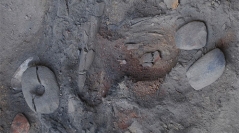

 Comptes Rendus Palevol
16 (3) - Pages 351-361
Comptes Rendus Palevol
16 (3) - Pages 351-361Throughout continental Southeast Asia, the Hoabinhian techno-complex stands out in clear contrast with the universal chrono-cultural model essentially established on the basis of western prehistory. Following this model, early authors considered perforated stones and associated lithic artefacts as markers of what was then believed to pertain to a Southeast Asian Mesolithic. However, Southeast Asian Mesolitithic has progressively been abandoned in favour of a ubiquitous Hoabinhian spanning from 30,000 to 3000 BP. Here, we present and discuss the discovery of perforated stones at the Doi Pha Kan site in northern Thailand. Perforated stones have almost never been found in undisturbed stratigraphic conditions nor dated with any sufficient degree of certainty. At Doi Pha Kan site, such a kind of artefacts was found in burials intersecting sedimentary layers that could be ascertained as Hoabinhian. In contrast with similar perforated stones described in the literature, that found at Doi Pha Kan are well-dated (13,000 BP), thus providing a time-reference for a putative Southeast Asian Mesolithic. We therefore advocate that such non-Hoabinhian artefacts support the early authors’ hypothesis of the existence of a Southeast Asian Mesolithic. Finally, the funerary practices, the unusually high stature of individuals found at Doi Pha Kan in conjunction with the particular lithic assemblages further contributes to raise the question of the co-occurrence of several cultures or populations at the Pleistocene–Holocene interface in continental Southeast Asia.
Dating, Southeast Asia, Hoabinhian, Mesolithic